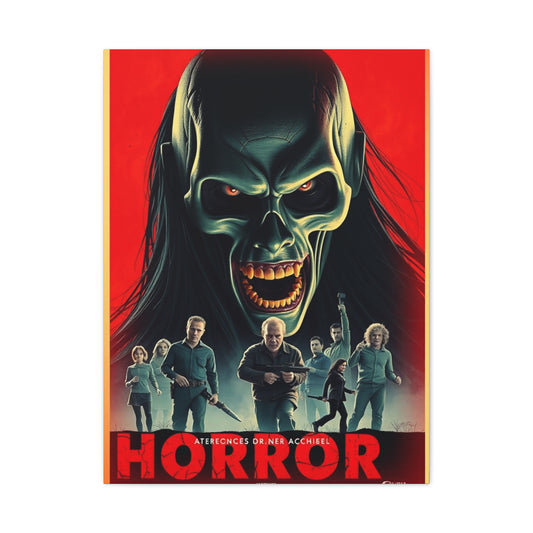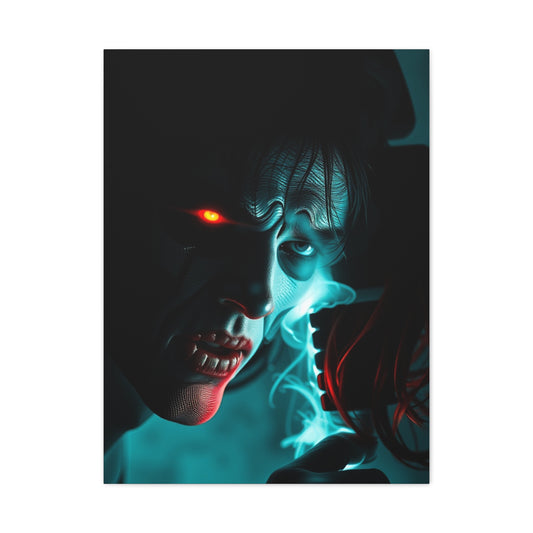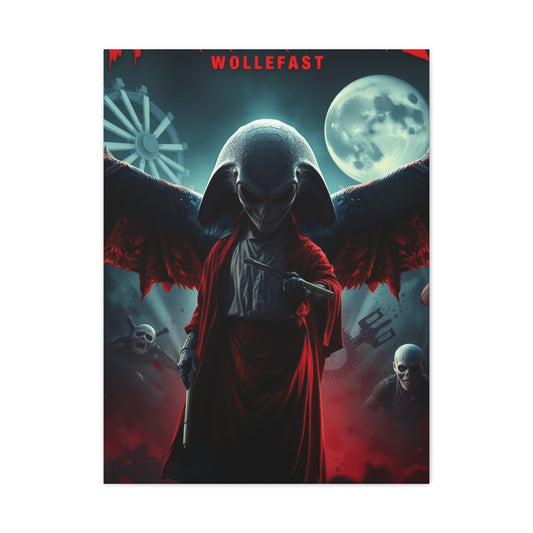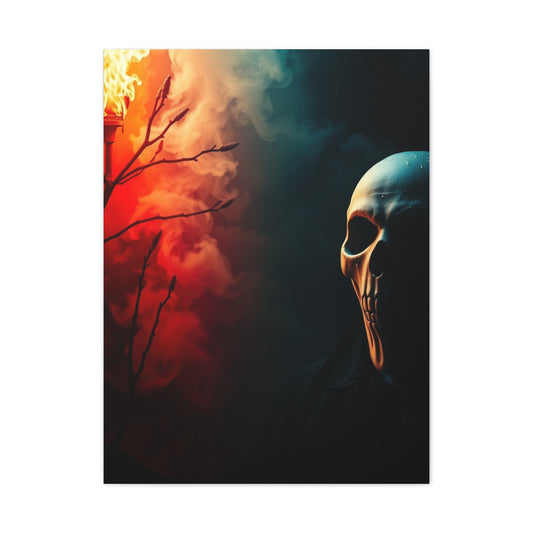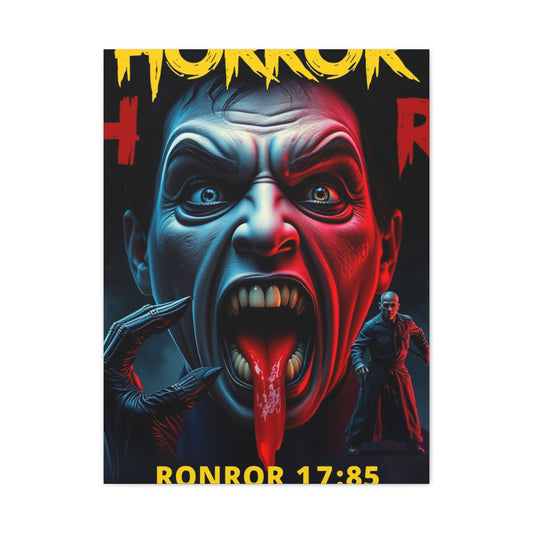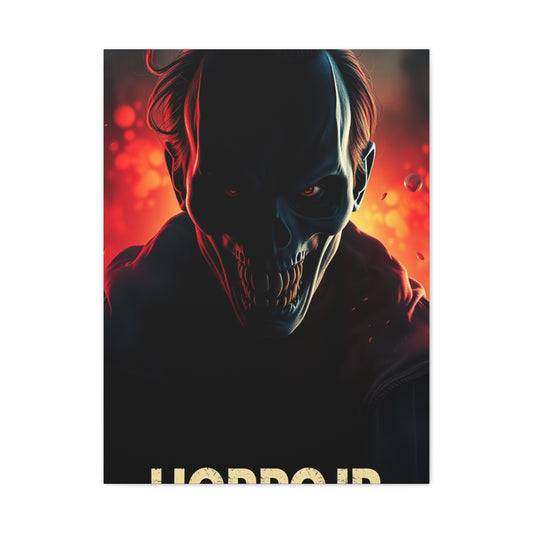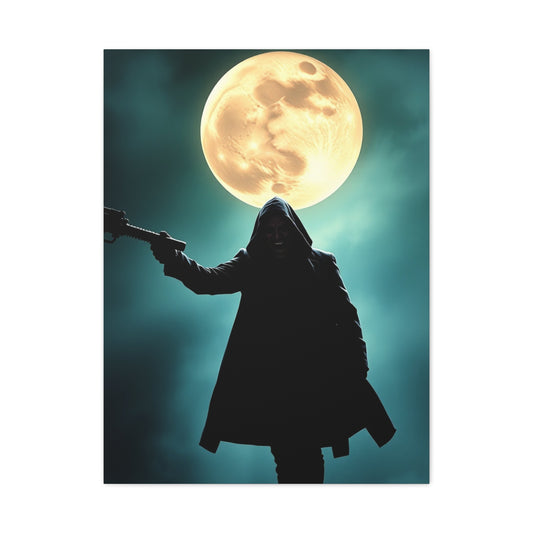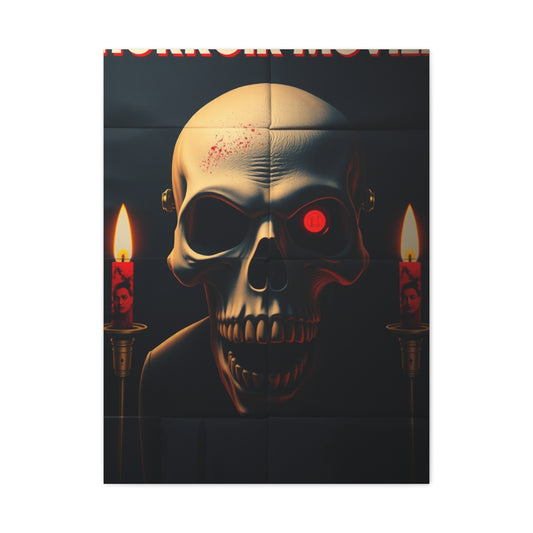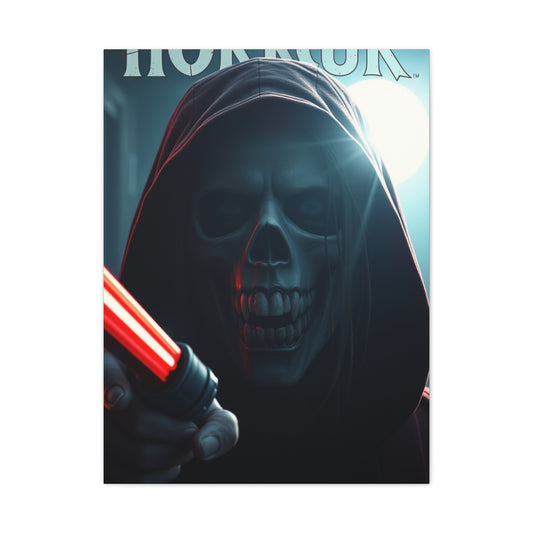Nightmare Wall Prints & Horror Movie Posters Wall Art Guide
The allure of darkness has captivated human imagination for centuries, manifesting itself through various artistic expressions that challenge conventional aesthetics. Contemporary interior design increasingly embraces the enigmatic realm of horror-themed wall decorations, creating atmospheric environments that celebrate the spine-tingling essence of cinematic terror. These carefully curated collections of nightmare wall prints and scary icon canvas pieces serve as powerful focal points that transform ordinary living spaces into immersive galleries dedicated to the art of fear.
Horror cinema has profoundly influenced visual culture, producing iconic imagery that transcends the silver screen to become enduring symbols of suspense and terror. The evolution of frightening film wall art reflects our collective fascination with the macabre, offering enthusiasts opportunities to incorporate beloved villains, memorable scenes, and atmospheric elements from their favorite productions into personal living environments. This artistic movement represents more than mere decoration; it embodies a lifestyle choice that celebrates the sophisticated appreciation of horror as legitimate entertainment and artistic expression.
The psychological impact of incorporating dark aesthetic elements into residential spaces extends beyond superficial decoration. These carefully selected pieces create conversation starters, establish personal identity markers, and demonstrate cultural literacy within the horror community. Spooky legends canvas prints serve as visual narratives that connect inhabitants with broader cultural movements while expressing individual taste preferences and emotional connections to specific cinematic experiences.
Professional interior designers increasingly recognize the sophistication inherent in horror-themed decorative elements, acknowledging their potential to create dramatic focal points and establish unique atmospheric qualities within residential and commercial spaces. The careful curation of dark screen wall décor requires understanding color theory, spatial relationships, and psychological impact to achieve desired aesthetic outcomes without overwhelming the environment or creating unwelcoming atmospheres.
Classic Horror Movie Posters
Vintage horror movie posters hold a unique place in the history of cinema and pop culture. These artistic creations are more than just marketing tools—they are visual time capsules that reflect the aesthetic, social, and cultural attitudes of their era. Often printed on thick, glossy paper with vivid, hand-painted imagery, classic horror posters captured the imagination of audiences and enticed them into theaters with promises of thrills, chills, and unforgettable experiences.
One of the most iconic examples is the 1931 poster for Dracula, starring Bela Lugosi. This poster is widely recognized for its striking composition: Lugosi’s piercing gaze dominates the image, exuding both charm and menace, while the gothic castle and looming shadows set an ominous tone. The typography is equally impactful, with dramatic, flowing letters that reinforce the mysterious and supernatural elements of the film. Posters like this were designed to evoke emotion immediately, using fear, curiosity, and fascination as tools to draw viewers in. The Dracula poster is more than promotional material—it is a symbol of the early horror genre itself, representing the blend of elegance and terror that would define Universal Studios’ golden era of horror.
Classic horror posters often relied on exaggerated imagery to communicate the danger and suspense within the film. Monsters with grotesque features, terrified victims, and dramatic lightning strikes were staples of the genre. The 1932 Frankenstein poster, featuring Boris Karloff, is another prime example. Karloff’s portrayal of the creature, combined with stark contrasts and shadowy effects, creates a sense of menace while also evoking sympathy for the misunderstood monster. The poster’s composition communicates both the horror of the narrative and the emotional depth of the characters, making it an enduring piece of visual storytelling.
Beyond their cinematic function, these posters are now considered collectible works of art. Original prints from the 1920s to the 1960s are highly sought after by collectors and historians alike, often fetching thousands of dollars at auctions. This enduring value is due not only to their rarity but also to the artistry involved. Unlike modern digital poster design, these vintage pieces were hand-drawn or painted, requiring skill, creativity, and a keen understanding of visual psychology. Artists had to capture the essence of the film in a single image that could grab attention from afar, making each poster a miniature masterpiece in composition, color, and emotion.
Furthermore, classic horror movie posters influenced later visual media, from comic books to album covers, and even contemporary horror film marketing. The bold use of color, the interplay of light and shadow, and the tendency to emphasize the most thrilling or grotesque elements became a template for horror aesthetics in broader culture. Posters for films like The Mummy (1932) and Creature from the Black Lagoon (1954) reinforced the dramatic conventions established by their predecessors while introducing new monsters and fantastical elements that expanded the genre’s visual vocabulary.
Modern Horror Movie Art
Contemporary horror movie posters have evolved far beyond the bold, lurid, and sometimes campy designs of earlier decades. While classic horror posters often relied on dramatic, hand-painted scenes, exaggerated expressions, and stark contrasts to grab attention, modern horror movie art employs a more sophisticated visual language. Today’s designers blend traditional horror motifs with innovative techniques in digital art, photography, and graphic design to create posters that are not only promotional materials but also standalone pieces of visual storytelling.
One of the defining features of modern horror movie art is the use of minimalist and abstract design elements. Unlike vintage posters, which often depicted monsters or dramatic action sequences, contemporary posters frequently rely on subtlety to provoke unease. For instance, the promotional art for Ari Aster’s Hereditary emphasizes sparse imagery and muted colors, highlighting the isolation and tension at the heart of the film. The poster’s focus on a single, unnerving object or a solitary figure evokes fear in a more psychological manner, appealing to viewers’ anticipation and imagination rather than showing explicit gore.
Color palettes in modern horror posters are carefully chosen to manipulate mood and emotion. Shades of gray, muted blues, sickly greens, and shadow-heavy blacks dominate many contemporary designs, creating an immediate sense of unease. Films like The Witch employ desaturated tones and natural lighting to suggest dread and mystery without revealing the horrors directly. This restraint allows viewers to project their own fears onto the imagery, making the poster an interactive psychological experience rather than a mere advertisement.
Digital technology has also significantly transformed horror movie art. Modern posters often incorporate photo manipulation, 3D effects, and layered textures to create unsettling compositions. Designers can blend photographic realism with surreal elements, making it difficult for the viewer to immediately distinguish between reality and fantasy. For example, Midsommar’s promotional art merges idyllic rural imagery with subtle hints of horror, foreshadowing the psychological disorientation and ritualistic terror that defines the movie. This fusion of beauty and horror heightens tension and engages audiences on a deeper level.
Another trend in modern horror poster design is the use of symbolism and visual storytelling. Designers embed subtle clues, motifs, or recurring symbols within the poster to hint at the narrative or thematic elements of the film. These symbols—whether a fragmented face, a mysterious shadow, or an ambiguous object—invite the viewer to explore the story before even entering the theater. In addition to sparking curiosity, this approach reflects a broader cultural shift in horror toward more cerebral and emotionally complex narratives, moving away from purely visceral scares.
Typography, too, plays a crucial role in contemporary horror movie art. Designers often favor understated fonts that integrate seamlessly into the composition, rather than loud, sensational lettering. The title of a film may appear almost as an afterthought, blending into the image to reinforce the mood rather than dominate it. This choice amplifies the psychological tension, leaving the viewer unsettled and intrigued.
Modern horror posters are not just marketing tools—they have become collectible pieces of art that appeal to fans and design enthusiasts alike. The combination of minimalist aesthetics, symbolic storytelling, and innovative digital techniques has elevated these posters to a form of contemporary art, worthy of gallery exhibitions and critical analysis. Collectors and horror aficionados often seek out these designs for their artistry, complexity, and ability to evoke emotional responses with subtlety and finesse.
Surreal Nightmare-Inspired Art
Nightmare-inspired art occupies a unique niche within the broader realm of surrealism, tapping into the subconscious fears and anxieties that often surface in dreams. Unlike conventional art that aims to depict reality or idealized forms, nightmare-inspired pieces explore the unsettling, the bizarre, and the psychologically provocative. This genre invites viewers to confront the strange and often disturbing imagery that lurks at the edges of human consciousness. By transforming fear and anxiety into visual form, artists can evoke powerful emotional reactions, from unease and tension to awe and fascination.
One of the most iconic examples of nightmare-inspired art is Henry Fuseli’s 1781 painting, The Nightmare. This work features a woman sprawled across a bed in deep, seemingly peaceful slumber, yet her vulnerable position is disrupted by the looming presence of a grotesque incubus perched on her chest. A ghostly horse with bulging eyes peers from the background, further amplifying the painting’s eerie quality. Fuseli’s use of shadow, contrast, and exaggerated forms effectively blurs the boundary between the real and the imagined, creating a visual experience that feels both hypnotic and terrifying. The painting’s impact lies not only in its technical mastery but also in its ability to externalize the intangible horrors of the human mind.
Surreal nightmare-inspired art extends far beyond the works of Fuseli, finding expression in numerous styles and mediums. Artists often employ distorted anatomy, fragmented landscapes, and illogical spatial arrangements to evoke a sense of disorientation. Figures may stretch, shrink, or morph into hybrid forms, while familiar objects are placed in unexpected or threatening contexts. This deliberate manipulation of reality mirrors the often chaotic and nonsensical nature of dreams, capturing the subconscious logic that governs nightmares. Salvador Dalí, for example, utilized melting clocks, barren landscapes, and surreal figures in works such as The Persistence of Memory to explore time, memory, and existential anxiety, themes commonly associated with dreamlike fear.
Color and lighting play crucial roles in nightmare-inspired art. Artists frequently rely on muted palettes, stark contrasts, or unnatural hues to heighten tension and evoke emotional responses. Shadows may be exaggerated to obscure details, leaving viewers uncertain about what lurks in the darkness. The interplay of light and shadow can create a sense of unease, making familiar environments appear hostile or alien. This atmospheric manipulation draws the viewer deeper into the artist’s imagined nightmare, fostering an immersive experience that is both captivating and disquieting.
Choosing the Right Horror Art for Your Space
Selecting the ideal horror or nightmare-themed artwork for your home or personal space is an exciting yet nuanced process. Horror art is incredibly versatile—it can range from classic monster illustrations to modern psychological thriller visuals—but the key is to ensure that the pieces you choose not only reflect your personal taste but also harmonize with the environment in which they are displayed. Thoughtful consideration of theme, color, size, placement, and framing can transform ordinary walls into captivating galleries that balance fear, intrigue, and aesthetic appeal.
Theme and Mood
The first and most important factor to consider is the theme and mood you want your space to convey. Horror art spans a wide spectrum: from the gothic elegance of classic horror icons like Dracula or Frankenstein to the surreal and unsettling imagery inspired by psychological thrillers. Supernatural themes, featuring ghosts, spirits, and otherworldly creatures, can evoke mystery and suspense, while slasher-inspired artwork or depictions of cinematic villains can bring an adrenaline-filled intensity to your room. Defining the mood you want to create helps narrow down the selection of prints, canvas art, or posters. For instance, if you wish to cultivate a chilling yet sophisticated ambiance, vintage horror movie posters or black-and-white sketches of classic monsters can be ideal choices. On the other hand, bold, graphic depictions of modern horror films can energize a more playful or edgy environment.
Color Palette
Color is a powerful tool in horror art, as it directly affects the atmosphere of your room. Dark, moody tones such as deep blacks, crimson reds, shadowy purples, and muted grays can create a sense of drama and intensity, making the artwork a central focal point of your space. These shades are particularly effective in rooms with neutral or minimal décor, as they provide a stark contrast and visually anchor the space. Conversely, incorporating contrasting or vibrant colors—such as neon greens, bright oranges, or stark whites—can highlight specific elements of the artwork and create a striking, attention-grabbing effect. When selecting horror art, consider how the color palette interacts with your furniture, wall colors, and lighting. Art that harmonizes with your existing décor will feel cohesive, whereas contrasting tones can make a statement or provoke intrigue.
Size and Placemen
The dimensions of your horror artwork and its placement on the wall are crucial to achieving visual balance. Large, dramatic pieces can serve as the centerpiece of a room, drawing the eye immediately and establishing the overall tone of the space. In contrast, smaller prints or canvases can be grouped in curated arrangements to create a gallery-style display, offering layered storytelling and a more intricate visual experience. Placement also matters: hanging art at eye level ensures it is easily appreciated, while positioning pieces above furniture or in corners can help fill awkward spaces without overwhelming the room. Consider the surrounding environment carefully; horror art works best when it has room to breathe and does not compete with excessive décor.
Frame Style
The framing of your horror artwork can significantly influence its presentation and impact. A carefully chosen frame can enhance the atmosphere of the piece while complementing the overall style of the room. Ornate, vintage frames with intricate details evoke a classic, timeless feel reminiscent of old horror films or Victorian Gothic aesthetics. Sleek, minimalistic frames, on the other hand, offer a contemporary edge that works well with modern interiors and allows the artwork itself to stand out without distraction. Some collectors even opt for frameless canvas prints or shadow boxes to add depth and dimension, creating a more immersive visual experience.
Ultimately, choosing horror art for your space is about balancing personal taste with thoughtful design considerations. By carefully selecting the theme, color palette, size, placement, and frame style, you can transform ordinary walls into captivating visual narratives that reflect both your love for horror and your unique sense of style. Whether you’re decorating a home theater, a bedroom, or a hallway, these elements work together to create a space that is visually striking, atmospherically engaging, and unmistakably yours. Horror art isn’t just decoration—it’s an invitation into worlds of mystery, suspense, and imagination, and the right choices can make your walls tell a story that captivates anyone who enters the room.
Impact of Horror-Themed Interior Design
The incorporation of gothic horror wall prints into residential environments creates complex psychological dynamics that extend beyond aesthetic considerations. Research in environmental psychology suggests that visual stimuli significantly influence mood, behavior patterns, and social interactions within domestic spaces. Horror-themed decorations can establish unique atmospheric qualities that reflect inhabitant personalities while creating distinctive experiential environments for guests and family members.
Controlled exposure to mildly threatening imagery through horror pop art posters can provide psychological benefits including stress inoculation and emotional regulation practice. These carefully curated visual experiences allow individuals to explore fear responses within safe, controlled environments while developing emotional resilience and coping mechanisms. The therapeutic potential of horror imagery has gained recognition among mental health professionals who acknowledge the value of controlled fear exposure for anxiety management.
Color psychology plays crucial roles in determining the psychological impact of thriller movie canvas installations. Deep reds evoke passion and intensity while potentially increasing energy levels and emotional arousal. Black elements create mystery and sophistication while potentially inducing contemplative moods. Strategic color combinations can achieve desired psychological effects while maintaining aesthetic balance and visual coherence throughout residential spaces.
Social psychology research indicates that environmental choices communicate identity markers and cultural affiliations to visitors and inhabitants. Cult horror wall décor selections demonstrate sophisticated cultural knowledge, rebellion against conventional aesthetic norms, and appreciation for alternative artistic expressions. These choices can facilitate connections with like-minded individuals while establishing personal brand identity within social networks.
The concept of "benign masochism" explains why individuals seek pleasurable experiences through controlled exposure to negative stimuli. Scary movie legends prints provide opportunities to experience thrills and excitement within familiar, secure environments. This psychological phenomenon underlies the popularity of horror entertainment and explains the appeal of incorporating related imagery into personal living spaces where comfort and security remain paramount.
Horror Cinema Wall Art
Contemporary horror villains wall art employs sophisticated artistic techniques that elevate simple character representations into compelling visual narratives. Digital manipulation allows artists to enhance dramatic lighting effects, intensify color saturation, and create atmospheric elements that capture the essence of cinematic moments. These technical capabilities enable the creation of museum-quality pieces that maintain artistic integrity while celebrating popular culture elements.
Mixed media approaches combine traditional painting techniques with digital enhancement to create suspense film canvas pieces that exhibit dimensional qualities and tactile appeal. Layered compositions incorporate photographic elements, hand-painted details, and digital effects to achieve visual complexity that rewards close examination while maintaining impact when viewed from distance. These sophisticated production methods justify premium pricing while delivering exceptional value to discerning collectors.
Typography integration represents another crucial artistic element in effective dark night wall posters design. Font selection, text placement, and color coordination must complement visual elements while maintaining readability and aesthetic balance. Successful pieces often incorporate period-appropriate typefaces that evoke specific cinematic eras while maintaining contemporary appeal and design sensibilities.
Composition principles borrowed from fine art traditions enhance the visual impact of fright fest canvas installations. Rule of thirds applications, leading line techniques, and focal point establishment create dynamic visual experiences that guide viewer attention through carefully planned viewing sequences. These compositional strategies ensure that horror-themed artwork maintains artistic credibility while celebrating entertainment industry subjects.
Color grading techniques adapted from film production enhance the atmospheric qualities of horror story wall prints by creating cohesive visual moods that reinforce thematic content. Selective desaturation, contrast enhancement, and hue shifting can transform ordinary imagery into compelling artistic statements that capture the essential character of source material while achieving independent aesthetic merit.
Cultural Significance of Horror Iconography
The cultural impact of horror cinema extends far beyond entertainment value, influencing fashion, music, literature, and visual arts in ways that continue shaping contemporary aesthetic sensibilities. Chilling cinema canvas collections serve as cultural artifacts that document the evolution of social fears, technological capabilities, and artistic expression throughout different historical periods. These pieces function as visual time capsules that preserve cultural moments for future analysis and appreciation.
Horror iconography often reflects underlying social anxieties and cultural tensions that define specific historical periods. Cold War-era science fiction horror explored themes of invasion and contamination that reflected contemporary political concerns. Modern horror addresses issues including technology dependence, environmental destruction, and social isolation through visual metaphors that resonate with current audience experiences and concerns.
The democratization of horror appreciation through accessible wall art collections has contributed to the mainstreaming of previously niche cultural interests. Ghostly horror wall art enables individuals to display cultural affiliations publicly while contributing to broader acceptance of horror as legitimate entertainment and artistic expression. This cultural shift reflects changing attitudes toward alternative aesthetics and unconventional lifestyle choices.
International horror traditions contribute unique visual elements to contemporary iconic villain posters that celebrate diverse cultural approaches to fear and supernatural themes. Japanese horror emphasizes psychological terror through subtle imagery and atmospheric elements. European horror often incorporates gothic architectural elements and historical references that create different aesthetic vocabularies for contemporary artists to explore and reinterpret.
The collector culture surrounding horror movie masterpiece canvas pieces has created communities of enthusiasts who share knowledge, trading opportunities, and appreciation for artistic excellence within the genre. These communities contribute to the cultural legitimacy of horror collecting while providing support networks for individuals who appreciate alternative aesthetic expressions.
Technical Considerations for Canvas Production
Modern printing technologies enable the production of high-quality horror-themed wall art that rivals traditional artistic mediums in terms of color accuracy, durability, and visual impact. Giclee printing processes utilize archival inks and museum-quality substrates to create pieces that maintain color integrity and structural stability over extended periods. These technical capabilities ensure that contemporary horror canvas installations can achieve longevity comparable to traditional artistic works.
Canvas material selection significantly impacts the final appearance and durability of horror-themed wall art installations. Cotton canvas provides excellent color absorption and texture retention while maintaining flexibility necessary for proper mounting and display. Polyester blends offer enhanced durability and moisture resistance that benefit installations in challenging environmental conditions while maintaining visual quality and aesthetic appeal.
Stretcher frame construction influences both the appearance and longevity of canvas installations. Professional-grade wooden frames provide structural stability while allowing for proper tension adjustment that prevents sagging and distortion over time. Gallery-wrap techniques eliminate visible staples and create clean edge presentations that enhance the professional appearance of horror-themed installations.
Protective coating applications can enhance the durability and maintenance characteristics of horror wall art while preserving color vibrancy and preventing environmental damage. UV-resistant treatments prevent fading from sunlight exposure while moisture barriers protect against humidity fluctuations that could compromise canvas integrity. These protective measures ensure long-term satisfaction with horror-themed decorative investments.
Professional mounting hardware selection ensures secure installation while protecting wall surfaces and artwork integrity. Appropriate hanging systems distribute weight evenly while allowing for easy repositioning and removal when necessary. These technical considerations contribute to successful installation outcomes that maximize the visual impact of horror-themed wall art collections.
Curating Effective Horror Wall Art Collections
Successful horror wall art curation requires balancing personal preferences with design principles that create cohesive, visually appealing installations. Theme coordination ensures that individual pieces complement each other while contributing to unified aesthetic statements that reflect sophisticated understanding of visual design principles. Effective curation demonstrates cultural knowledge while creating environments that remain comfortable and welcoming for inhabitants and guests.
Scale relationships between individual pieces and installation spaces significantly impact visual effectiveness and environmental integration. Oversized pieces can overwhelm smaller rooms while undersized artwork may appear insignificant in larger spaces. Proper scale selection ensures that horror-themed artwork achieves desired impact while maintaining proportional relationships with surrounding architectural elements and furnishings.
Color palette coordination prevents visual chaos while allowing for creative expression and thematic development. Monochromatic approaches create sophisticated, unified appearances while limited color schemes can achieve dramatic impact without overwhelming viewers. Strategic color coordination enables the integration of diverse horror themes within cohesive design frameworks that demonstrate curatorial expertise.
Lighting design plays crucial roles in maximizing the impact of horror wall art installations. Dramatic lighting can enhance atmospheric qualities while poor illumination diminishes visual effectiveness and reduces appreciation opportunities. Professional lighting consultation may benefit significant installations where optimal presentation justifies additional investment in specialized illumination equipment.
Seasonal rotation strategies enable collectors to maintain fresh appearances while accommodating growing collections within limited display spaces. Strategic piece rotation prevents visual fatigue while providing opportunities to rediscover previously displayed works. These curatorial practices maximize enjoyment from horror wall art investments while maintaining dynamic, evolving environmental experiences.
Horror Decorative Arts
The horror wall art market continues expanding as mainstream acceptance grows and production technologies improve accessibility and quality standards. Limited edition releases create collector value while mass-produced options enable broader participation in horror decorating trends. Market segmentation accommodates diverse budget ranges while maintaining quality standards that satisfy both casual enthusiasts and serious collectors.
Digital art marketplaces have revolutionized distribution methods for horror-themed wall art, enabling artists to reach global audiences while reducing production and inventory costs. Print-on-demand services allow for extensive catalog offerings without substantial upfront investments while maintaining quality control and customer satisfaction standards. These technological developments benefit both artists and consumers through improved accessibility and selection variety.
Licensing agreements with entertainment studios enable the legal production of officially sanctioned horror wall art that maintains authenticity while supporting original creators. These partnerships ensure quality control while providing legal protection for consumers and producers. Official licensing also validates horror collecting as legitimate cultural activity while supporting continued development of horror entertainment properties.
Artisan collaborations with independent artists create unique, limited-production pieces that offer exclusivity and artistic credibility. These partnerships often produce innovative approaches to horror imagery while supporting emerging artists and expanding creative possibilities within the genre. Collector interest in unique pieces drives demand for artistic collaborations that produce distinctive works unavailable through mass production channels.
Investment potential in high-quality horror wall art continues growing as cultural acceptance increases and production quality improves. Limited editions, artist signatures, and official licensing contribute to long-term value retention while aesthetic appeal ensures continued enjoyment regardless of financial considerations. These investment characteristics attract collectors who appreciate both artistic merit and potential financial returns.
Installation and Display Strategies
Professional installation techniques maximize the visual impact of horror wall art while protecting both artwork and architectural surfaces. Proper wall preparation, hardware selection, and placement planning ensure secure mounting that withstands environmental stresses while maintaining optimal viewing positions. Professional installation services may justify additional costs for valuable pieces or challenging installation circumstances.
Gallery lighting principles can enhance horror wall art presentation through strategic illumination that highlights details while creating dramatic atmospheric effects. Track lighting systems provide flexibility for accent lighting while recessed fixtures offer subtle general illumination that prevents glare and shadows. Lighting color temperature selection influences mood creation while maintaining color accuracy in artwork reproduction.
Grouping strategies enable the creation of compelling visual narratives through thoughtful arrangement of related pieces. Symmetrical arrangements create formal, balanced presentations while asymmetrical compositions generate dynamic visual interest and movement. Theme-based groupings tell coherent visual stories while eclectic arrangements demonstrate broad cultural knowledge and sophisticated curatorial abilities.
Height placement considerations ensure optimal viewing experiences while accommodating diverse viewer perspectives and room usage patterns. Standard gallery height recommendations provide starting points for placement decisions while specific circumstances may require adjustments for optimal integration with existing furnishings and architectural elements. Consistent height relationships create professional presentations that demonstrate attention to design details.
Spacing calculations prevent overcrowding while ensuring adequate visual impact from individual pieces and overall installations. Mathematical approaches to spacing create precise, professional appearances while intuitive spacing may achieve more organic, comfortable presentations. Balance between systematic and intuitive approaches often produces optimal results that satisfy both aesthetic and practical requirements.
Maintenance and Preservation Techniques
Proper maintenance practices extend the lifespan and preserve the appearance of horror wall art investments while preventing damage from environmental factors and handling errors. Regular cleaning schedules prevent accumulation of dust and contaminants that can damage canvas surfaces and degrade color quality over time. Appropriate cleaning materials and techniques protect artwork integrity while maintaining visual appeal and investment value.
Environmental control measures protect horror wall art from damaging factors including direct sunlight, temperature fluctuations, and humidity extremes. Window treatments filter harmful UV radiation while climate control systems maintain stable environmental conditions that prevent expansion and contraction damage. These protective measures justify additional costs through extended artwork lifespan and maintained appearance quality.
Storage solutions for rotated pieces protect unused artwork while facilitating easy access for display rotation programs. Proper storage materials prevent moisture damage, physical distortion, and surface contamination while maintaining organization systems that enable efficient piece location and retrieval. Investment in quality storage systems protects valuable collections while enabling flexible display strategies.
Professional restoration services can address damage from accidents, environmental exposure, or aging processes that compromise artwork appearance or structural integrity. Early intervention often prevents minor damage from progressing to major problems that require expensive repairs or result in permanent loss. Professional consultation helps determine appropriate restoration approaches while preserving original artistic intentions and value.
Insurance considerations protect financial investments in horror wall art collections while providing peace of mind regarding potential loss or damage. Proper documentation through photography and appraisal records supports insurance claims while facilitating accurate replacement value determination. Regular valuation updates ensure adequate coverage as collections grow and market values fluctuate.
Integration with Contemporary Interior Design
Modern interior design increasingly embraces eclectic approaches that accommodate diverse aesthetic preferences within cohesive design frameworks. Horror wall art integration requires balancing thematic elements with overall room design while maintaining comfort and functionality for daily living. Successful integration demonstrates sophisticated design understanding while creating unique, personalized environments that reflect inhabitant personalities.
Color coordination strategies enable horror wall art integration within diverse design schemes through careful selection of pieces that complement existing color palettes. Neutral backgrounds allow horror artwork to serve as focal points while coordinated accent colors create visual connections between artwork and furnishings. These coordination techniques demonstrate design sophistication while accommodating personal aesthetic preferences.
Texture mixing combines horror wall art with diverse material selections that create visual interest and tactile appeal. Smooth canvas surfaces contrast effectively with rough textiles, polished metals, and natural wood elements while maintaining overall design coherence. Strategic texture selection enhances the visual impact of horror artwork while creating dynamic, engaging environments.
Furniture selection influences the effectiveness of horror wall art integration through scale relationships, color coordination, and style compatibility. Modern furniture often complements horror artwork through clean lines and neutral colors while antique pieces can create compelling contrasts that enhance dramatic impact. Strategic furniture choices support horror art integration while maintaining functional living environments.
Architectural element coordination ensures that horror wall art installations complement existing room features while addressing potential conflicts with permanent fixtures. Crown molding, window treatments, and built-in features can either enhance or compete with wall art installations depending on coordination strategies. Successful integration demonstrates comprehensive design planning and execution skills.
Horror Art Appreciation
Controlled exposure to horror imagery through wall art provides psychological benefits including stress relief, emotional regulation practice, and creative inspiration. The safe exploration of fear responses within familiar environments enables individuals to develop coping mechanisms while enjoying aesthetic experiences that challenge conventional beauty standards. These psychological benefits justify horror art appreciation as legitimate wellness practice rather than mere entertainment consumption.
Cathartic release through horror imagery appreciation allows individuals to process negative emotions and stress responses in healthy, controlled manners. The symbolic representation of fears and anxieties through artistic expression provides outlets for emotional processing while maintaining psychological safety and control. These therapeutic aspects of horror appreciation contribute to overall mental health and emotional resilience.
Social bonding opportunities arise from shared horror art appreciation that facilitates connections with like-minded individuals who appreciate alternative aesthetic expressions. Horror collecting communities provide support networks and shared experiences that contribute to social wellbeing and cultural participation. These community connections demonstrate the social value of horror art appreciation beyond individual aesthetic enjoyment.
Creative inspiration from horror wall art exposure can stimulate artistic expression, storytelling abilities, and imaginative thinking in viewers who engage thoughtfully with challenging imagery. The symbolic richness and visual complexity of effective horror art provides mental stimulation that exercises creative faculties while expanding aesthetic appreciation capabilities. These cognitive benefits justify horror art collection as intellectually enriching activity.
Confidence building through appreciation of unconventional aesthetic choices demonstrates independence, cultural sophistication, and personal authenticity that contribute to positive self-image and social presence. The ability to appreciate and discuss complex artistic expressions enhances cultural literacy while demonstrating intellectual curiosity and aesthetic courage. These personal development benefits extend beyond simple decoration preferences to encompass broader character development.
Future Developments in Horror Wall Art
Technological advancement continues expanding possibilities for horror wall art production through innovations in printing technology, material science, and digital art creation. Emerging technologies including augmented reality integration, interactive elements, and dynamic display systems may revolutionize horror art presentation while maintaining traditional aesthetic values. These developments promise enhanced viewer experiences while preserving the fundamental appeal of static visual art.
Virtual reality applications could enable immersive horror art experiences that extend beyond traditional wall mounting limitations while maintaining the collectible nature of physical artwork. Hybrid approaches combining physical pieces with digital enhancement might create new categories of horror art that satisfy both traditional collectors and technology enthusiasts. These innovations could expand market appeal while preserving established collector communities.
Sustainable production methods increasingly influence horror wall art manufacturing through environmentally conscious material selection and production processes. Eco-friendly inks, recycled substrates, and carbon-neutral shipping options appeal to environmentally conscious consumers while maintaining quality standards and aesthetic appeal. These sustainable practices contribute to long-term market viability while addressing contemporary environmental concerns.
Artificial intelligence applications in art creation may influence horror imagery generation while raising questions about artistic authenticity and human creativity. AI-assisted design tools could democratize art creation while potentially threatening traditional artist livelihoods. The integration of AI capabilities within horror art production will require careful consideration of ethical implications and artistic value questions.
Customization technologies enable personalized horror art creation that incorporates individual preferences, personal imagery, and unique specifications within professional production frameworks. Made-to-order services could expand market accessibility while maintaining quality standards and artistic credibility. These customization capabilities may reshape collector expectations while creating new opportunities for artistic expression and personal connection.
Cultural Impact and Social Acceptance
The mainstream acceptance of horror aesthetics reflects broader cultural shifts toward diversity, inclusivity, and alternative expression validation. Horror wall art normalization demonstrates society's growing comfort with unconventional beauty standards while acknowledging the artistic merit inherent in challenging imagery. This cultural evolution benefits collectors through reduced stigma and increased availability of high-quality options.
Educational institutions increasingly recognize horror studies as legitimate academic discipline worthy of scholarly attention and cultural analysis. University programs examining horror literature, cinema, and visual arts provide intellectual frameworks for understanding horror aesthetics while validating collector interests as culturally significant activities. These academic developments contribute to horror art legitimacy while expanding appreciation beyond entertainment value.
Museum exhibitions featuring horror-themed artwork demonstrate institutional recognition of the genre's artistic and cultural significance. Major museums incorporating horror elements into permanent collections validate collector activities while exposing broader audiences to sophisticated horror aesthetic expressions. These institutional endorsements contribute to cultural legitimacy while expanding market awareness and appreciation.
Intergenerational transmission of horror appreciation creates lasting cultural impact as parents share favorite films, books, and imagery with children who develop personal connections to horror traditions. Family collecting activities build shared cultural experiences while preserving horror heritage for future generations. These transmission patterns ensure continued cultural relevance and market stability for horror wall art collections.
Media coverage of horror collecting and interior design applications increases public awareness while reducing stigma associated with alternative aesthetic choices. Lifestyle publications featuring horror-themed rooms demonstrate mainstream acceptance while providing inspiration and validation for current collectors. Positive media representation contributes to cultural normalization while expanding potential market participation.
Considerations for Collectors
Budget planning strategies enable collectors to build meaningful horror wall art collections within financial constraints while maximizing aesthetic impact and long-term satisfaction. Systematic purchasing approaches prevent impulse decisions while ensuring collection coherence and quality standards. Strategic budgeting accommodates both immediate gratification and long-term collection development goals through balanced spending priorities.
Value assessment techniques help collectors make informed purchasing decisions while building collections that maintain or appreciate in financial worth over time. Understanding factors including artist reputation, production quality, rarity, and cultural significance enables strategic acquisition decisions that balance aesthetic preferences with investment considerations. These evaluation skills benefit both casual collectors and serious investors.
Financing options including payment plans, layaway programs, and credit arrangements make high-quality horror wall art accessible to collectors with limited immediate spending capacity. Flexible payment structures enable the acquisition of premium pieces while managing cash flow requirements and budget constraints. These financing alternatives expand market participation while maintaining quality standards and artist compensation.
Insurance and security considerations protect valuable horror art collections from theft, damage, and loss while providing financial protection for significant investments. Appropriate coverage levels, documentation requirements, and security measures ensure adequate protection while facilitating recovery from potential losses. These protective measures justify collection investments while providing peace of mind for collectors.
Resale market dynamics influence collection development strategies through understanding of demand patterns, pricing trends, and liquidity factors that affect future selling opportunities. Knowledge of secondary markets enables strategic collection building while providing exit strategies for evolving taste preferences or financial needs. These market insights benefit both buyers and sellers within the horror collecting community.
Conclusion:
The realm of horror wall art represents far more than simple decorative choices; it embodies a sophisticated cultural movement that celebrates the artistic merit inherent in challenging, provocative imagery while creating deeply personal living environments that reflect individual taste and cultural literacy. The evolution from niche collecting activity to mainstream interior design consideration demonstrates society's growing appreciation for aesthetic diversity and alternative beauty standards that challenge conventional decorating wisdom.
Contemporary horror wall art collections serve multiple functions within modern living spaces, functioning simultaneously as conversation starters, cultural artifacts, artistic statements, and personal identity markers that communicate sophisticated taste and cultural knowledge to visitors and inhabitants alike. The careful curation of nightmare wall prints, scary icon canvas pieces, and frightening film wall art requires understanding of design principles, cultural significance, and psychological impact that elevates collection activities from simple consumption to thoughtful cultural participation and artistic appreciation.
The psychological benefits associated with controlled horror imagery exposure through wall art installations extend beyond superficial decoration to encompass stress relief, emotional regulation practice, creative inspiration, and social bonding opportunities that contribute meaningfully to overall wellbeing and cultural engagement. These therapeutic aspects validate horror art appreciation as legitimate wellness practice while providing intellectual justification for investment in high-quality pieces that deliver lasting satisfaction and meaningful experiential value.
Technological advancement continues expanding possibilities for horror wall art creation, distribution, and presentation while maintaining respect for traditional artistic values and collector preferences. Digital printing innovations, sustainable production methods, and emerging presentation technologies promise enhanced accessibility and quality while preserving the fundamental appeal of physical artwork that can be owned, displayed, and shared within personal living environments.
The economic aspects of horror wall art collecting offer opportunities for both aesthetic enjoyment and financial appreciation as cultural acceptance grows and production quality continues improving. Strategic collection development can achieve personal satisfaction while building valuable assets that reflect cultural trends and artistic merit. These investment characteristics attract collectors who appreciate both immediate aesthetic rewards and potential long-term financial benefits from thoughtful acquisition strategies.
Professional installation, proper maintenance, and strategic integration with existing interior design elements maximize the impact and longevity of horror wall art investments while creating cohesive, comfortable living environments that successfully balance thematic elements with daily functionality requirements. These technical considerations ensure that horror-themed decorating achieves desired atmospheric effects while maintaining practical livability and broad appeal to family members and guests.
The social aspects of horror collecting create community connections and shared experiences that extend beyond individual appreciation to encompass broader cultural participation and friendship development. These community elements provide support networks, knowledge sharing opportunities, and validation for collecting activities while contributing to the mainstream acceptance and cultural legitimacy of horror aesthetics within contemporary society.
Educational and institutional recognition of horror studies as legitimate academic discipline provides intellectual frameworks for understanding the cultural significance and artistic merit of horror wall art collections. University programs, museum exhibitions, and scholarly research validate collector interests while expanding public appreciation for horror aesthetics as worthy of serious cultural consideration and artistic analysis.

